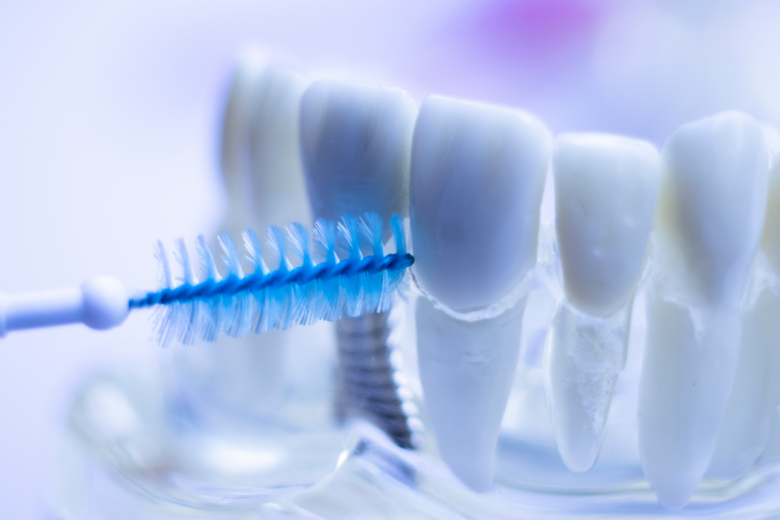Introduction
When it comes to maintaining oral health, brushing and flossing are essential, but there’s a tool you might not be using enough: the interdental brush. If you’ve never heard of it before, you might be wondering, What is interdental brushing for? Simply put, it’s a specialized tool designed to clean between your teeth, reaching areas that even dental floss might miss. But how does it contribute to gum health? Let’s dive into the details and uncover the benefits of this often-overlooked oral hygiene tool.
While most of us are familiar with the basics of oral hygiene, such as brushing and flossing, there’s a key tool that often gets overlooked— the interdental brush. This small but powerful tool is designed to clean between your teeth and along the gum line, where traditional toothbrushes and floss may not be able to reach effectively. If you’ve never used an interdental brush, you may be missing out on a vital step in preventing gum disease and maintaining overall oral health. In this article, we’ll explore the benefits of interdental brushing, why it’s essential for gum health, and how incorporating it into your routine can make a significant difference in your oral care regimen.
Understanding the Basics of Gum Health
The Anatomy of Your Gums
Your gums are the soft tissue that surrounds and supports your teeth. They’re not just there to look pretty—they play a crucial role in protecting your teeth from bacteria and plaque buildup. Healthy gums are firm, pale pink, and don’t bleed when you brush or floss. However, when gums become inflamed, they can lead to gum disease, which can seriously affect your oral health.
How Healthy Gums Contribute to Overall Oral Health
Healthy gums serve as a protective barrier against infections and cavities. When your gums are in tip-top shape, they help prevent plaque from building up along your teeth, which could lead to tooth decay and gum disease. Healthy gums also contribute to fresher breath and a more confident smile.
What is Interdental Brushing?
Interdental Brushes vs Traditional Floss
Interdental brushes are small, conical brushes designed to fit between your teeth. Unlike traditional dental floss, which can be tricky to maneuver around tight spaces, interdental brushes are often easier to use, especially for those with wider gaps between their teeth or dental work like braces or implants.
How Interdental Brushing Works
The brush’s bristles are designed to sweep away food particles, plaque, and bacteria that accumulate in the spaces between your teeth. Regular use of interdental brushes helps prevent gum disease and tooth decay by ensuring that no harmful debris is left behind.
The Benefits of Interdental Brushing
Cleaner Spaces Between Teeth
Using an interdental brush helps you achieve cleaner, fresher teeth by thoroughly removing plaque buildup in places that floss might miss. By regularly brushing between your teeth, you reduce the risk of plaque hardening into tartar, which can only be removed by a dentist.
Reduction in Gum Inflammation
Regular interdental brushing helps reduce inflammation and bleeding gums. This is particularly beneficial for people prone to gingivitis, a common gum disease that causes swollen and bleeding gums. When plaque isn’t removed from between the teeth, it can irritate the gums, leading to further complications.
How Does Interdental Brushing Help Gum Health?
Removal of Plaque and Bacteria
Plaque is a sticky film of bacteria that forms on teeth and gums. If left unchecked, it can lead to gum disease and tooth decay. By using an interdental brush, you effectively remove plaque and harmful bacteria from between your teeth, helping your gums stay healthy and free from infection.
Preventing Gum Disease and Tooth Decay
Plaque buildup in the spaces between your teeth can cause gum disease and tooth decay if not cleaned regularly. Interdental brushing helps remove this buildup, lowering your chances of developing gum disease, tooth cavities, and bad breath.
The Science Behind Interdental Brushing
How It Reduces Gingivitis
Gingivitis is a mild form of gum disease characterized by inflammation, redness, and swelling. It’s often caused by plaque buildup at the gumline. Studies show that using interdental brushes regularly can reduce gingivitis symptoms by effectively cleaning the areas between the teeth, where plaque tends to accumulate the most.
The Role of Interdental Brushing in Periodontal Health
Periodontitis is a more severe form of gum disease that affects the deeper layers of the gums and bone. Using an interdental brush can help prevent the progression of gingivitis to periodontitis by keeping plaque and bacteria at bay. This can protect your gums from long-term damage.
Interdental Brushing and the Prevention of Gum Disease
The Connection Between Plaque and Gum Disease
Plaque is the primary cause of gum disease. When plaque builds up on the teeth, it irritates the gums, causing them to swell, bleed, and become tender. Over time, this can lead to more serious conditions like periodontitis. Interdental brushing helps disrupt plaque formation by cleaning areas that are hard to reach.
Interdental Brushes as a Tool for Preventing Periodontitis
By removing plaque and bacteria from between the teeth, interdental brushes prevent the onset of periodontitis, a severe form of gum disease. Regular brushing ensures that harmful buildup doesn’t settle along the gumline, reducing the chances of gum infections and tooth loss.
How to Use an Interdental Brush Properly
Step-by-Step Guide for Beginners
If you’re new to interdental brushing, here’s how to get started:
- Choose the Right Size: Make sure you pick an interdental brush that fits comfortably between your teeth without forcing it.
- Insert the Brush Gently: Insert the brush at a slight angle and move it back and forth.
- Clean Both Sides: Gently brush both sides of the gap between your teeth to remove plaque and food particles.
- Rinse After Use: Clean the brush under running water after each use to remove debris.
Tips for Using Interdental Brushes Effectively
- Use gentle pressure when brushing to avoid damaging the gums.
- Replace your brush regularly to ensure it’s effective at cleaning.
- Don’t rush—take your time to thoroughly clean each space between your teeth.
Common Mistakes People Make with Interdental Brushes
Using the Wrong Size Brush
Choosing the wrong size brush can lead to ineffective cleaning or discomfort. If the brush is too large, it won’t fit between your teeth properly. If it’s too small, it won’t clean effectively. Be sure to choose the right size for each gap between your teeth.
Overuse or Improper Technique
While it’s important to clean between your teeth regularly, overusing the interdental brush can irritate your gums. Always use gentle pressure and avoid pushing the brush too hard between your teeth.
When Should You Use Interdental Brushes?
Frequency Recommendations from Dental Professionals
Most dental professionals recommend using an interdental brush once a day, ideally before brushing your teeth. This ensures that plaque is removed from between the teeth before it hardens into tartar.
Timing of Interdental Brushing in Your Oral Care Routine
You can use your interdental brush either in the morning or at night, but make sure it’s part of your daily oral hygiene routine. This consistency is key to maintaining gum health.
Who Should Use Interdental Brushes?
People with Braces, Implants, or Bridges
Interdental brushes are especially beneficial for people with braces, dental implants, or bridges, as these dental appliances create spaces that are difficult to clean with traditional floss.
Those at Higher Risk for Gum Disease
If you have a history of gum disease or are at risk due to conditions like diabetes or smoking, interdental brushing is an excellent way to protect your gums and prevent future problems.
The Differences Between Interdental Brushes and Other Tools
Comparing with Dental Floss, Soft Picks, and Water Flossers
While floss is a great tool, interdental brushes are more effective at cleaning wider gaps between teeth. Soft picks and water flossers are also useful, but they don’t remove as much plaque as interdental brushes. Choose the tool that best fits your dental needs.
Which Tool is Right for You?
Your choice depends on the size of the gaps between your teeth and your personal comfort. For tight spaces, dental floss might work best, but for wider gaps, an interdental brush is the most effective option.
The Impact of Interdental Brushing on Overall Health
Oral Health and Its Connection to Systemic Health
Your oral health is more connected to your overall health than you might think. Poor gum health can lead to serious conditions like heart disease, diabetes, and stroke. Keeping your gums healthy with interdental brushing can help protect your body from these risks.
How Gum Disease Affects Other Parts of the Body
Gum disease has been linked to various systemic conditions, including respiratory infections and complications during pregnancy. By maintaining healthy gums, you’re not only protecting your smile but also your overall health.
Choosing the Right Interdental Brush for Your Needs
How to Find the Right Size
Interdental brushes come in various sizes. A dentist can help you determine which size works best for your gaps. It’s important to use the right size to get the most effective clean without damaging your gums.
Features to Look for in Quality Brushes
Look for brushes with sturdy handles and durable bristles. Brushes with ergonomic grips can make cleaning easier and more comfortable.
Maintaining Healthy Gums for a Lifetime
Importance of Regular Dental Visits
Even though interdental brushing is crucial for gum health, regular dental checkups are essential for detecting early signs of gum disease and other oral issues.
The Role of Interdental Brushing in Long-Term Gum Care
By incorporating interdental brushing into your daily routine, you’re taking proactive steps to maintain healthy gums for years to come.
In conclusion, interdental brushing is a game-changer for gum health. It effectively cleans between your teeth, removes plaque, and helps prevent gum disease. By using the right technique and choosing the right tools, you can keep your gums healthy and happy, contributing to better overall health. So, why not make interdental brushing a part of your daily oral care routine?
Incorporating interdental brushing into your daily routine not only improves gum health but also enhances your overall oral hygiene. By targeting areas that are often missed by traditional brushing and flossing, interdental brushes help reduce the buildup of plaque and bacteria, preventing potential oral issues before they arise. With regular use, you can experience healthier gums, fresher breath, and a reduced risk of cavities and gum disease. The benefits are clear—taking a few extra minutes each day to use an interdental brush can go a long way in maintaining a bright, healthy smile. So, make interdental brushing an essential part of your oral care routine, and enjoy the rewards of better gum health and a more confident smile.




